The Parents’ Guide to Safe Climates (During Corona):
100 Ways to Engage & Empower Kids K-12, Fight for Their Future — and Not Lose Your Mind
Dear Reader: This is a menu of ideas, not a to-do list. I updated ideas from my book The Parents’ Guide to Climate Revolution for parents now working from home, overseeing family physical distancing, and homeschooling. I’ve also pulled from lists such as Parents For Future UK’s Stay At Home Green Learning.
My list has 7 sections of **mostly screen-free** activities: self & family care, community connections, living simply, empowering & educating kids, and building a fossil-free future. Pick what resonates and let the rest go. May these ideas help you and your family thrive during COVID and in our larger, shared climate emergency. – Mary
Care for Your Body, Mind & Soul
1 Lower your parenting bar. My sister: “If your kids are alive at the end of the day, you’re doing fine.”
2 Lower your housekeeping standards. (No one’s visiting anytime soon).
3 Make spaces magical with twinkle lights. One cheap string of tiny lights transforms a room.
4 Breathe. Practice taking three deep breaths whenever you’re anxious or pissed. It’ll relax your overall nervous system. Teach kids to do this and other easy stress-relieving practices for kids.
5 Get support. Find a “whine buddy” and take turns listening to each other by phone (use cars for privacy!). Join the Facebook support group Coronavirus Parents: Parenting in a Pandemic; Consider trading room and board to a cash-strapped student for 10 hrs a week of child care.
6 Care for yourself. Get at least 7 hours of sleep a night. Follow a regular sleep schedule, if you can. Turn off screens 1 hour before bed. Exile TVs, computers, and phones from bedrooms. Try screen settings that reduce blue light after dark. Get fresh air and sunshine, even if only for a 5-minute walk around the block. Soak in that vitamin D!
7 Pray or meditate. If possible, do it with others, even online; people with spiritual communities report feeling happier than those without.Make love: It’s fun, good for our health, and relaxes the body (flying solo works, too). Eat veggies. Take vit. B for stress, especially if you’re veggie.
8 Exercise aerobically. Jump rope, run stairs. Even 20 min. boosts moods (& helps parenting).
9 Try online yoga, exercise, and meditation. Yoga with Adrienne is free, or your local studio might offer free Zoom classes. With kids, try this wildlife-themed yoga.
10 Change Your Media / Digital Diet. Limit TV news. Shelter kids from daily death tolls. Model how to live well without the cultural default of binge-watching TV (ideas below). Give yourself permission not to “keep up.”
11 Look at the bigger picture. Remember that sheltering in place, social distancing, and hand washing for 30 seconds are inconvenient, but they’re privileges not afforded to people in crowded conditions — prisons, refugee camps, and those in impoverished countries.
12 “When you see the empty streets . . . don’t say ‘It looks like the end of the world.’ It’s the most remarkable act of global solidarity we may ever witness.” (Facebook quote redacted)
Connect with your Covid-crew
13 Clean those hands. Wash for30 seconds, with lots of soapy scrubbing.One mom got her resistant toddler into hand-washing once she renamed it “Making Soap Soup.” Try these recipes for natural, homemade hand sanitizers (includes kid-safe versions).
14 Speak reassuringly to kids about COVID. This PBS article has specific tips and language for younger kids. And this chart by Caroline De Robertis might help:
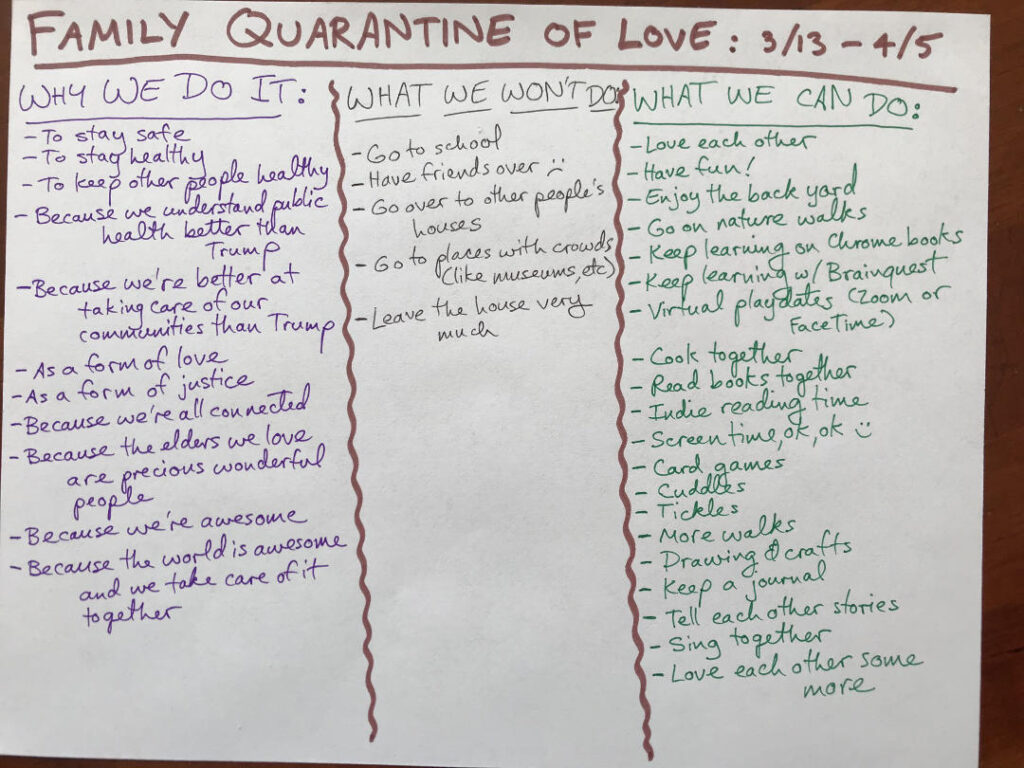
15 Listen to and validate kids’ feelings. Everything just changed for kids. Ask how they’re doing. Don’t judge feelings or try to fix anything; just give loving attention so they feel safe to express themselves. Or post a feelings chart.
16 Try family meetings. When everyone’s rested and fed, check in, make menu plans, chore charts and shopping lists, plan this week’s recess games, or solve problems together.
17 Exude Gratitude. Listing gratitudes helps all of us. My family’s “Corona Communication Board” has columns for requests and cool things to do together — and one just for us to praise each other.
18 Take a tour of your kids’ music. Really listen, read the words, ask what they love and why. Try to delight in each song they share with you it—or at least find something positive to say about it. Then, flip it, sharing one of your favorites.
Connect with community (and faraway family)
19 Help kids connect with older, ill, lonely, or grieving relatives. Deliver groceries or medicine; do yard work; check in by phone, through a window, from the porch; invite kids to draw or write “3 things I love about you” letters to photograph and send electronically.
20 Help kids connect with neighbors. Invite them to hang colorful messages of cheer on telephone poles or in apartment building hallways, or offers of help to neighbors in need.
21 Put a teddy bear in your window. Find out if your community is participating in “Going for a Bear Hunt” – kids out counting teddy bears in windows. Or, help kids initiate the game in your neighborhood.
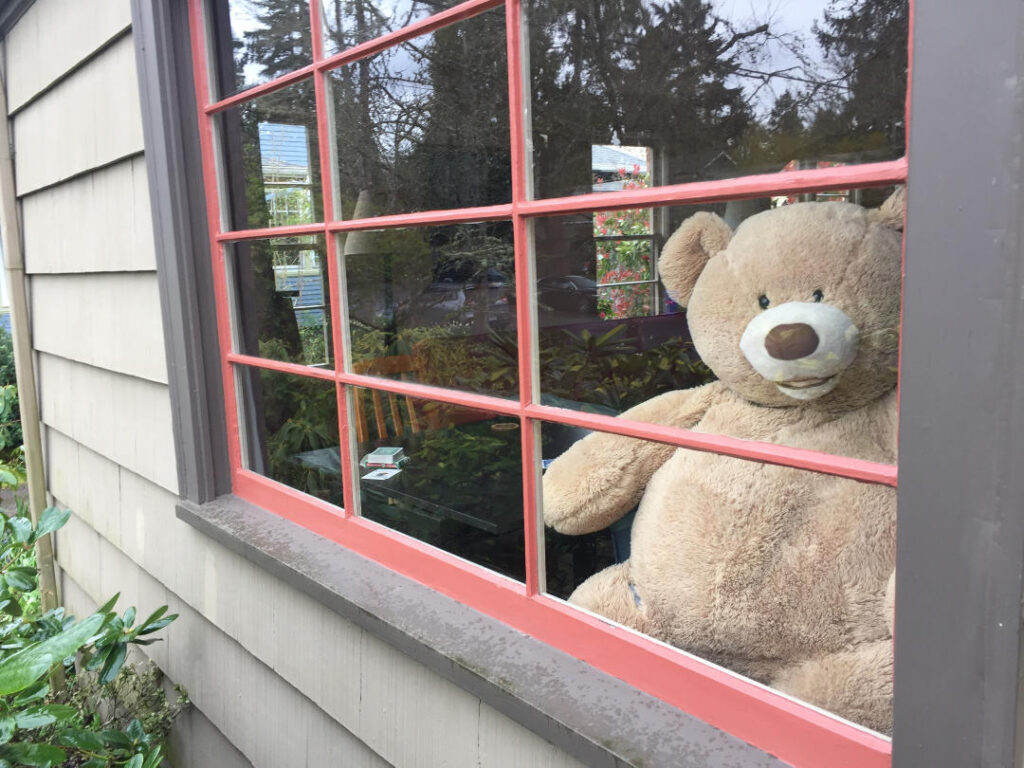
22 Celebrate! For birthdays, graduations, or other milestones, try bike or driving parades past the recipient’s house with balloons, signs, and songs. Try an indoor tropical party: Crank the heat, don swimsuits, swig mango or pineapple smoothies (best with umbrellas), dance to beach-theme tunes, and do a limbo contest.
23 Give graduation gifts early. Many young people would appreciate gift money right now.
24 Invite kids to give a porch, courtyard, or balcony concert, dance, or juggling performance. Invite neighbors, friends, and family.
25 Support local stores. Many local independent bookstores now offer curbside pickup or mail delivery.Find natural food networks offering delivery of local food products from bakeries, farms, and other natural food producers.
26 Let your farmer feed you. Shop outdoor farmer’s markets or join a Community Supported Agriculture (CSA) program for fresh veggies delivered weekly to a drop-spot near you. Local Harvest can help you find one near you.
27 Feed one another. 11 million US kids face hunger. Use Feeding America to find your local food bank and donate $ or canned goods. FoodFinder helps folks find nearby food assistance.
28 Love up health care workers – and get them PPEs. Put kid-made “thank you health care workers” signs in your window, in chalk messages on sidewalks, or online. Learn here how to make or donate personal protective equipment (PPE), drive supplies to support front line workers, or spread the word about PPE campaigns near you.
Educate and Empower Kids – at Home
29 Make your yard or balcony a nature preserve. This site has activities for connecting with and protecting wildlife, from learning to identify bees to making a birdfeeder to planting a “nectar bar” for pollinators. Help birds avoid windows. Try these sea horse and octopus coloring sheets.
30 Practice bicycling skills. Now’s the time to teach bicycle safety and practice in light traffic!
31 Try a “vending machine fridge.” On weekends, make batches of healthy lunches — soup, pasta salad, dips. — and put individual portions into containers for kids to serve themselves.
32 Let kids organize your household’s disaster preparedness. Challenge them to take this household disaster readiness quiz, then put ‘em in charge of organizing supplies and plans. Fired up kids can take on this more thorough training toolkit.
33 Teach kids to use knives, fire & power tools. Here’s my list of skills, by age, kids need in today’s world, including the ability to safely use sharp knives. Includes skills for building a fossil-free world, living generously, and thriving in a changing world — no matter how fierce its storms.
34 For adults and teens, enjoy great fiction about isolation & survival. Circe by Madeline Miller; Where the Crawdads Sing by Delia Owens; The Martian by Andy Weir (movie too). The romantic movie Five Feet Apart is about teens enduring medical isolation – pretty darn apropos!
35 Try bibliotherapy that empowers kids – and builds empathy. For a list of 500 great youth novels, including 50 about the environment, try Better With Books: 500 Diverse Books to Ignite Empathy and Encourage Self-Acceptance in Tweens and Teens by Melissa Hart.

36 Give kids empowering, earth-friendly magazines. Kazoo (girls), Skipping Stones (multicultural, by and for kids), Highlights, Ranger Rick (outdoors). For teens,Rolling Stone has great climate articles, including this recent one on teen activist Greta Thunberg.
37 Sing along with kid CDs.The Seal Maiden by Karan Casey & friends; Disney’s Pirates of the Caribbeansing-along; Raffi CDs; Red Grammer’s Sing-Along Songs; Hamilton
38 Share tales of perseverance – and triumph – by social justice heroes. My list of book and movie recommendations will help your family get inspired by real-life heroes.
39 Be a blackout poet. Try this easy, fun way to create original poetry.
 40 Try an eco-film fest (in the living room). Choose a pro-planet move from this list. Watch with faraway loved ones at the same time, and discuss after.
40 Try an eco-film fest (in the living room). Choose a pro-planet move from this list. Watch with faraway loved ones at the same time, and discuss after.
41 Discuss how “Everything is connected to everything else.” Talk with kids about COVID, how it impacts family & friends, local businesses, civil rights, 2020 elections, our environment. Discuss that, like the climate crisis, it disproportionately impacts the poor and people of color. Help kids find reliable information (below). Listen to their opinions, questions, worries, solutions.
42 Introduce older teens to today’s hot climate writers and revolutionaries.
Emily Atkin’s Heated newsletter; Bill McKibben’s free Climate Crisis newsletter in The New Yorker; On Fire: The Burning Case for a Green New Deal by Naomi Klein; No One Is Too Small to Make a Difference by Greta Thunberg; Beautiful Trouble: A Toolbox for Revolution – book or card game; Youth to Power:Your Voice and How to Use It by Jamie Margolin (releases 6/2/20).
43 Encourage attendance at Sunrise School. Sunrise Movement’s youth activists are “seizing this moment to become the leaders we need.” Build connections; learn how to “confront the crises gripping society, and take action . . . while social distancing.”
44 Race to learn the 52-word preamble to the Constitution. Few people know that our Constitution guarantees our “posterity,” meaning our kids, the right to both freedom and good lives (which means the right to a livable planet). Who can recite that preamble by memory first?
45 Learn the Fossil Fuel Nitty Gritties. Find out, from my 19-year-old niece’s 4-pg cartoon, how fossil fuels are made – and why they’ve gotta stay in the ground.
46 Get inspired by some badass youth activists. Check out Sunrise Movement; Earth Guardians, led by teen Xiuhtezcatl Martinez; Zero Hour, led by teen Jamie Margolin; Fridays For Future, led by Greta Thunberg, and connect with kids from your local school climate clubs.
47 Meet some kids suing the president. “We are the 21 young Juliana plaintiffs suing the federal government to defend the rights of youth and future generations.”
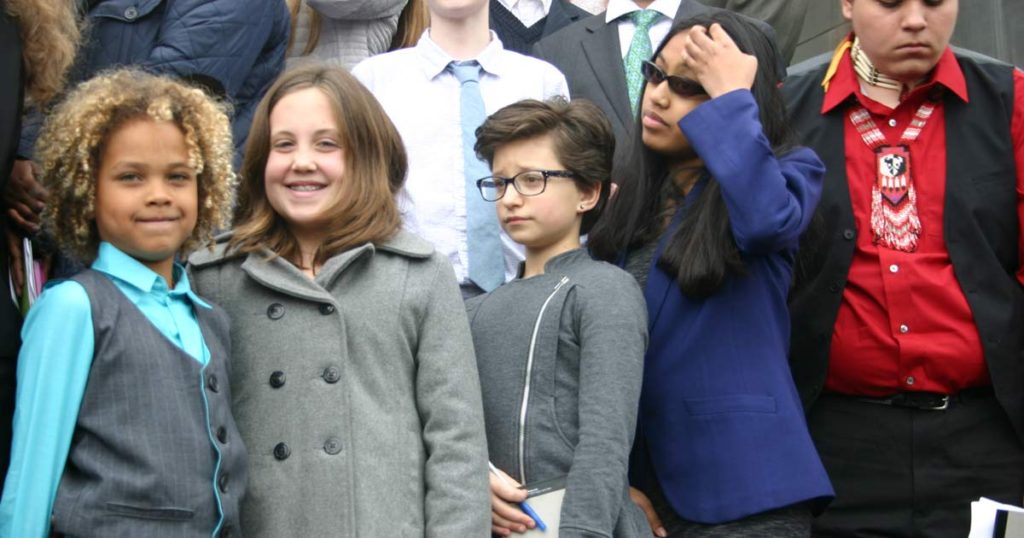
48 Amplify youth voices. Follow youth leaders such as those above, then follow some of the other, less-famous but equally passionate youth activists they follow. Retweet, “Like” their posts, offer encouraging comments, and share youths’ strikes, op-eds, and campaigns widely.
49 Keep kids safe online. Protect yourself and your kids from those new, nasty Zoom Bombers with these Zoom meeting tips. Protect kids online overall with the help of these guidelines.
50 Inoculate everyone from climate denial. Use this easy, 2-step “inoculation” against climate misinformation. Help your family be less susceptible to climate BS when they next step in it!
51 Look to the Sky. This is a great time to learn about clean, abundant, free energy from sun and wind. The Solar Schoolhouse offers great educational support. The wonderful, true story of The Boy Who Harnessed the Wind comes in early reader, middle grade, and YA versions.
52 Check out this Sea Level Rise Viewer interactive tool. Find out how your town – or the grandparents’ oceanside home — will fare under various rising “sea-narios.”
53 Try bird watching. Kids can learn to identify birds (try free apps like Merlin Bird ID), thenbecome citizen scientists with eBird.org.
54 Unleash creativity everywhere. Invite kid artistry on storage boxes, recipe cards, spice or bulk food jars, envelopes, shoes, jeans. T-shirts, shower curtains, doors, walls.
55 Invite kids to journal about this experience. They’re living through an extraordinary time. Encourage them to draw, journal, photograph about it. They’ll be happy to revisit it one day.
56 Write a novel. NaNoWriMo is a supportive online writing community challenging members to throw down a novel in 30 days. It has an April “camp” and a youth program.
57 Get creative for isolated friends and family. Create a kid puppet show story with Legos, dolls, or stuffies, and perform for loved ones over video calls. Or try a song, swapping in COVID-lyrics to a musical (let this family’s Les Misérables version inspire your crew).
58 Make a promise to the future. Send a video, letter, or photograph to an important person in your life – your child, a friend, a family member or your future self — as part of the Dear Tomorrow project. Together, brainstorm with your child about action(s) they’d like to take on behalf of future generations; facilitate their sharing it out.
59 Invite kids: Make a drawing of things we’re doing at home for the Earth and all future generations. Send to relatives.
60 Learn how to write a press release. Editors & producers love to hear from kid activists!
Make Recess Fun (** 95% Screen-Free!)
61 Get everyone moving inside – without special equipment.
- Indoor obstacle courses (simple ones work, too)
- Toilet Paper Boots (see top photo: kids push feet between TP rolls. Add dance music)
- Wear Your Closet: Kids don several layers of clothing and dance or run a simple obstacle course
- King of the Bed: Kids battle to push one another off of parents’ bed
- Dish Towel Tag: Snap teens with a cloth napkin or dish towel without actually hurting them (warning: quickly becomes an indoor chase)
- Indoor flashlight tag (leader has flashlight; others hide and try to tag leader before getting tagged themselves by the light).
- If you can acquire equipment, try:Indoor basketball, Velcro dartboard game, Nerf gun battles, ping pong on your dining table, hacky sacks, juggling balls, mega-mags, jacks
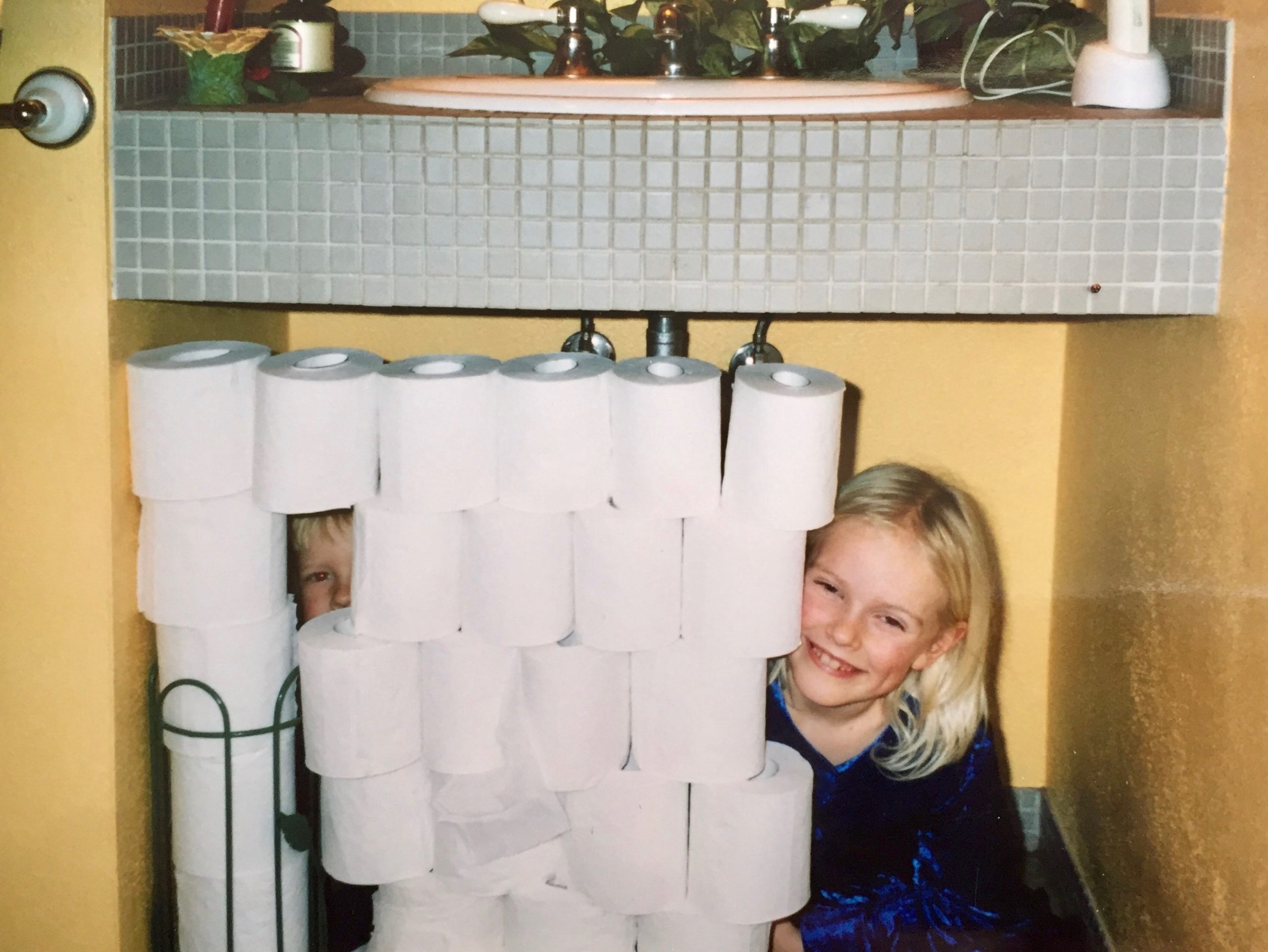
62 Play Games. These require nothing special. Salad Bowl (our all-time fave); In the Manner of the Adverb; Charades; “If you love me, smile”. Draw a Checkers board on cardboard & use coins for pieces. Regular card games: Rummy 500, Go Fish, BS, Capitalism, 2s and 3s, Hearts
- Specialty games: UNO; Slamwich; Rat-a-Tat-Cat; Trigger; Spot-it; Catan; Pictionary; Mancala; Balderdash, Catch Phrase; BattleShip; Codenames; Connect 4; Stratego; Backgammon
63 Encourage indoor creative play. Try masks, capes, play swords, kazoos, ukuleles, penny whistles, slide whistles, magic trick books and supplies. Try fort-building clips (pricey but long-lasting) to make it easy for kids to construct simple, magical forts from furniture and fabric.
64 Acquire these for outdoor play: Jump ropes; coffee-can and string (for “stilts”); shovels, buckets, and a hose for outdoor free play; balls of all shapes and sizes; badminton (can substitute rope for a net); basketball hoop tacked to outdoor wall; Frisbees; hacky sacks; slacklines; dartboards; bows and arrows (cardboard boxes or hay bales as targets); scooters
65 Try these games for outdoor recess with physical distancing (PD). Hopscotch; Obstacle courses on foot or bike; Red Light, Green Light or Potato Sack Race with PD variations: Place start / end points 6+ feet apart; have kids cross a personal line or base instead of tagging anyone); Skipping stone contests; Throw-the-rock-the-farthest-out-in-the-water contest.
66 Kick out the (corona) blues. Have a living room dance party with these happy, hopeful songs!
67 Turn mask-wearing into a daily kid costume party. Wearing masks in public is now recommended to reduce the spread or COVID-19. For kids, reframe mask-wearing as “We’re going outside in costume!” – try ninjas, ghosts, any animal. Every day’s Halloween!
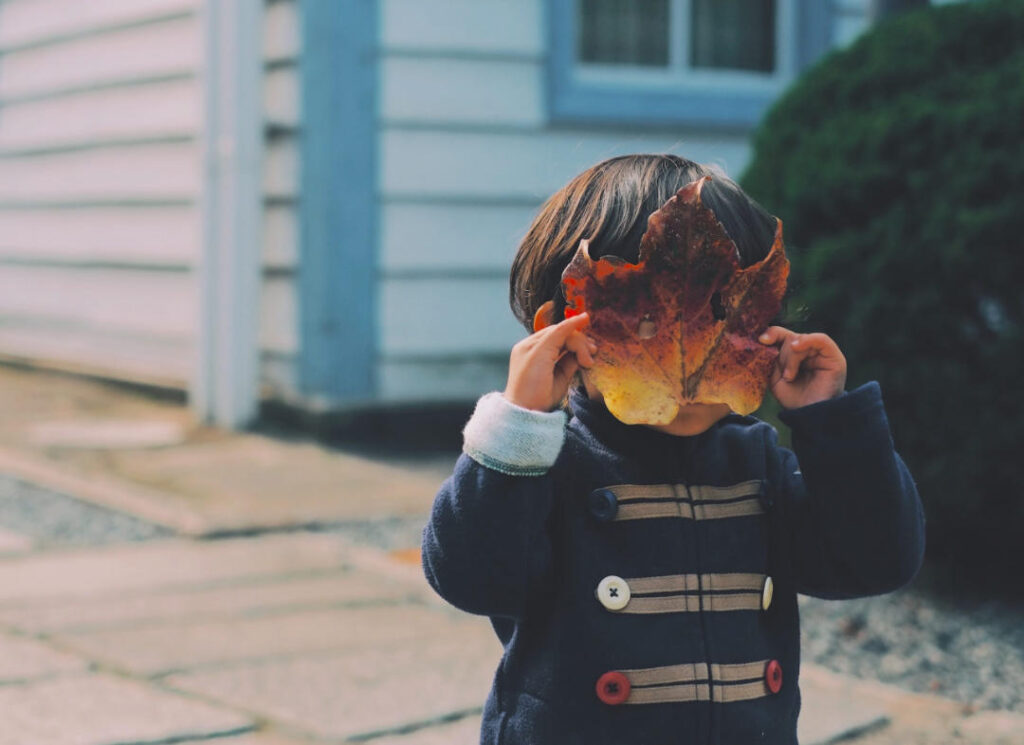
68 Howl with your pack. Start a group howl at the same time nightly to let off steam and connect with neighbors. Or join your local community’s nightly cheer to thank medical workers.
69 Challenge kids to invent a new outdoor game. Or try our “Steal the Water Bottle”: Adults lounge and visit outside at night (6+ ft apart) with a water bottle by their chair leg. Their kid tries to be the first to steal their own parents’ water bottle without their parent spotting them (each kid has their own ‘base” they must return to when called out). This game bought us hours of lazy visiting adult time as kids — happily, slowly and stealthily — crawled around nearby in the dark.
70 Unplug the kids. It’s hard. That’s why the parenting advice under corona is often “Surrender to screens.” I’d temper that let-it-go advice with this: Do what you must. And . . . we’ll be home awhile and it’s really hard to dial back screen time once kids get a lot of it. To limit screen time, we used phone controls as well as Disney’s Circle router, programming it to pull the plug after X number of minutes daily and filter content. Make it easier to be off screens than on by stocking your home with alluring books, games, puzzles, kid cookbooks, magazines, instruments, art supplies, indoor sports equipment & toys. Establish routines and screen-free zones and times.
71 Bring on the Awe. It makes us nicer and happier. Prod everyone outside for the next sunset, full moon, lightning storm, rainbow, or hummingbird — or at least look out the window for 30 seconds. Over dinner or at bedtime, invite kids to share one moment from the day that provoked wonder or awe.
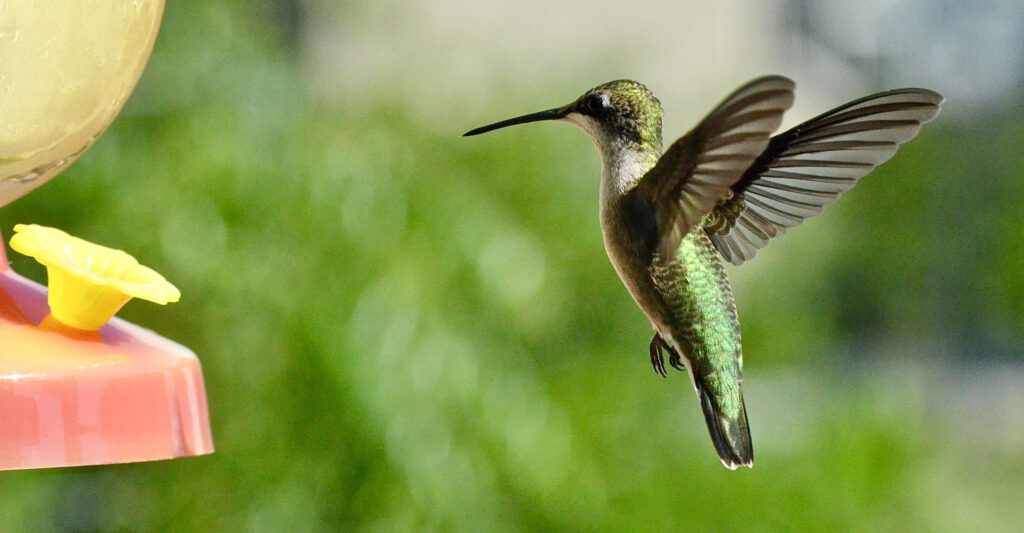
72 Try these simple, nature-based activities at home or in your garden.Or, if you have a camera, try “light painting” inspired by bioluminescent creatures living deep in the sea.
73 Take a virtual field trip (if you can’t get outside). I’d rather kids were on a balcony watching ants or making chalk art than watching otters onscreen, but I’ll include this list of online nature tours and “trips” for those wanting online nature-oriented educational resources.
74 Virtual Hide and Go Seek (ditto on screen disclaimer above). From Growing Play blog: Video call a friend on Facetime or another platform. Decide who will be Player 1 and hide first. Hang up. Player 2 counts to 50 while Player 1 hides somewhere in their house. Player 1 video calls Player 2, who must guess what room Player 1 is hiding in. Player 1 can give clues.
75 Bring Paris to you. Spend a day “traveling”: Make French crepes for breakfast (sugar-free recipe here). Dine with French music such as French Dreamlandby Putumayo. Tour the Louvre online, then watch French movies like The Fairy, A Cat in Paris, or for teens, The Intouchables. Try “plein air” painting (outside, in natural light).
Live more simply and more green (and save money)
76 Challenge kids to cut food waste. Americans waste 40% of our food, which hurts our wallets and Earth. Those misleading “Eat by” date stamps on food are the main culprits. With kids, learn how to know what’s safe to eat when. Challenge kids to cook using what’s on hand.
77 Shack up with worms!For worm bins, read Mary Appelhof ’s Worms Eat My Garbage!or watch this primer, “Worm Composting”.
78 Pass on the Gas. If you can afford to invest in them, solar panels and electric vehicles save you money in the long run. Swap out fracked-gas appliances for an electric or induction stove, on-demand water heater, solar water-heater panels, or passive solar for your house. Ask your utility about the process, cost, and tax incentives. Look into leasing solar panels. Ask EnergySage, about federal solar tax credits available through 2021.
79 Play the electric meter game. Ask kids to watch the electric meter in continuous motion. Then, challenge them to find out: How slowly can they make it go? How much energy is used when every appliance seems to be “off”? What’s the impact on the meter as specific appliances (like computers and TVs) are turned on? How many can be turned off and kept off until needed?
80 Eat mostly plants. It’s a great time to expand your rice ‘n bean repertoire (try these recipes). They’re affordable, easily storable, and work for most diets. Plus, plant-based meals are healthy and are easier on the climate than those with dairy and meat, especially beef.
81 Turn Fido Into a climate hero. As you walk your dog, remember: Much of the waste that’s left on the ground in parks ends up in river and streams, wreaking havoc on water quality and wildlife. Grab that pooch poo and, if possible, flush bacteria-laden feces in the toilet so they’re appropriately processed, not landfilled. To protect waterways, walk Fido far from them.
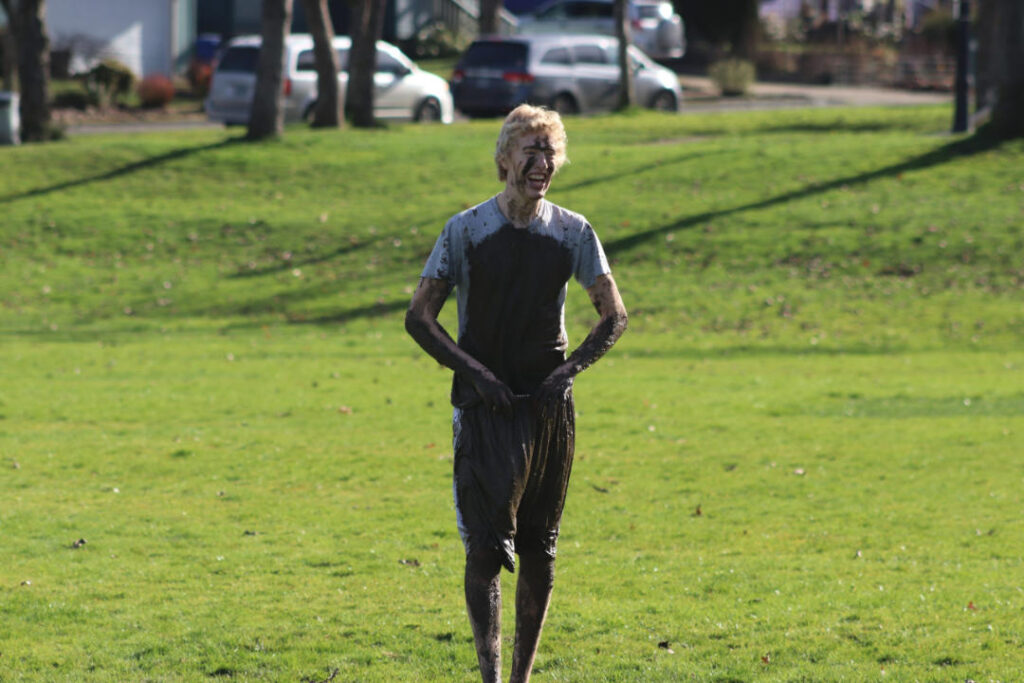
82 Get dirty. Dirt’s good for us! Get everyone’s hands in it at whatever level is manageable for you (my level = pots on my porch with store-bought starts of lettuce, kale, peas, herbs, parsley). Here are container garden projects for kids.
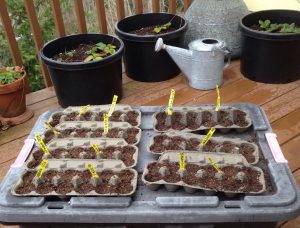
83 Don’t fear your cloth bags. The plastics industry is exploiting our fears to roll back efforts to reduce single-use bags and containers. Some stores let you load your bags yourself so your grocer doesn’t handle them. Read more here: “The best way to avoid getting Covid-19 from an inanimate object—whether it’s new or used—is not to touch your eyes, nose, or mouth after you touch it.”
Build a Fossil-Free Future / Protest from Home
84 Understand how Trump, Republicans, and the fossil fuel industry are ruthlessly exploiting this crisis to end EPA enforcement of all environmental laws and lock us into fossil fuel infrastructure, including Keystone Pipeline. Read about their evil strategy here. Support landowners facing eminent domain seizure for the Jordan Cove Pipeline here.
85 Be the 3.5 Percent. Be heartened by research finding that nonviolent movements are nearly always successful when they involve 3.5 percent of the population. C’mon, we can do 3.5%!
86 Get accurate climate news, including innovations & victories. Grist, YES! Magazine, and Yale Climate Connections all have free e-newsletters short enough for uber-busy parents.
87 Hound representatives. Demand relief packages prioritizing people, not corporations. Learn about and demand a Green New Deal to solve the climate crisis while creating millions of jobs.
88 Learn how to talk about the Green New Deal. This Sunrise Movement guide can help with those Zoom family reunions, when relatives ask what y’all have been up to with homeschooling.
89 Support student strikes. Help kids partake in FridaysForFuture. Make and display signs, then share photos on social media. #DigitalStrike #SilentStrike #ClimateStrike #FridaysForFuture #ClimateHowl
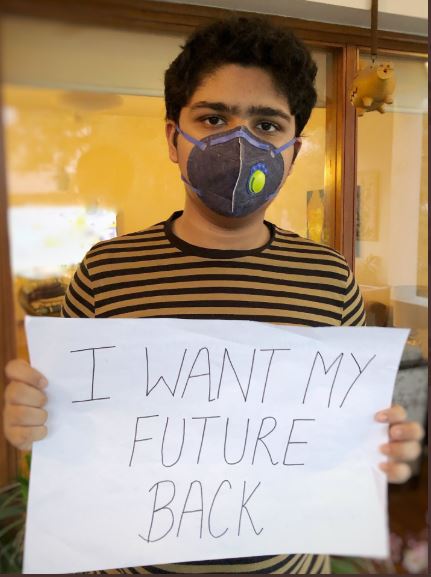
Student Climate Striker in Delhi, India
90 Divest (& urge everyone to). Dump your bank if it’s JP Morgan Chase, Citi, Bank of America, or Wells Fargo – the top funders of pipelines and dirty energy projects. Switch to your local credit union. Ask loved ones to go fossil free (here’s my sample divestment letter). Join Stop the Money Pipeline.
91 Grow your resilience. Sign up for a free International Transformational Resilience Coalition workshop to gain the emotional tools we’ll need to mitigate the climate crisis together.
92 Learn how wildly different the two major US parties 2020 platforms are. With kids, read Democrats’ energy platform, “Combat Climate Change, Build a Clean Energy Economy, and Secure Environmental Justice.” The Republican Party environment / energy platformis a fiercely pro-coal, gas, and oil document that should be required reading for everyone age 12+.
93 Join online art protests. Check out this creative online collaborative art protest and this free, in-depth and stellar Climate Strike Arts Kit (pandemic version).

Find these and more posters and templates in the “Climate Strike Arts Kit” (link above).
94 Unleash creative protest in public spaces you control. I’ve used my front lawn. Invite kids to splash their visions across your front door, windows, and the front of your house. Hang protest banners from bikes, balconies, roof tops, flag poles, and public spaces that cry out for color and imagination. Chalk or stencil messages on sidewalks and streets.
95 Get Out The Vote from home. “Rock the Vote is a nonpartisan nonprofit dedicated to building the political power of young people.” Try Swing Left, Indivisible or local campaign HQs.
96 Put pro-climate justice posters up everywhere. Use tacks, masking tape or this at-home wheat paste recipe. You can also buy liquid glue to make it all go faster.
97 Tweak “Going for a Bear Hunt” for Earth Day. Remember that cute Teddy bear above? Let’s tweak that into “Going for an Earth Hunt” game: Ask neighbors to put pictures of Earth — or a pledge of something they’ll do now to protect it — in their window for kids to spot and count.
98 Turn the freeway into your podium. Check out Freeway Blogger and the messages he hangs on bridges, reaching hundreds of thousands of people. Includes step-by-step tutorial on making big, cheap, easy-to-read signs.
99 Project onto buildings. Borrow or rent a strong projector. Pick a nice wall on a central building (it’s legal) and project your message; can be simple words, photos or elaborate videos.
100 Enjoy the peace – and imagine what else is possible. Take in the quiet. Breathe cleaner air. Notice the clearer waterways and emissions going downward. Notice the ways your family has done with less. With kids, imagine what’s possible in the climate crisis for humanity – and all life on earth – with the kind of cooperation, care, and solidarity we’re seeing in the COVID crisis. Commit to fighting together for a thriving future for all.
Thanks for being on this journey with me.
With love and determination and chapped hands,
Mary
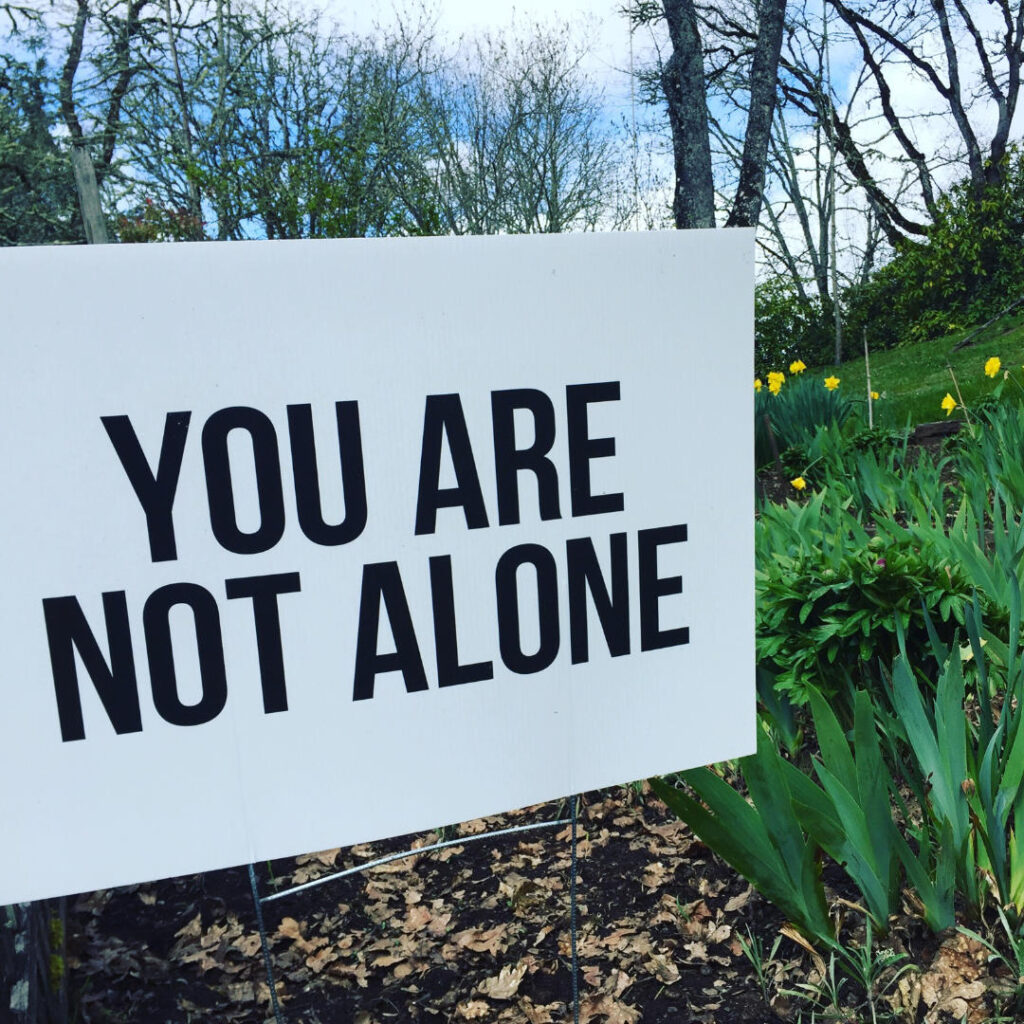
List By Mary DeMocker, based on her book The Parents’ Guide to Climate Revolution: 100 Ways to Build a Fossil-Free Future, Raise Empowered Kids and Still Get a Good Night’s Sleep (New World Library 2018, foreword Bill McKibben). Copyright 2020, all rights reserved. List may be freely distributed but not reproduced or shared without author attribution. Downloadable PDF Version Available here.

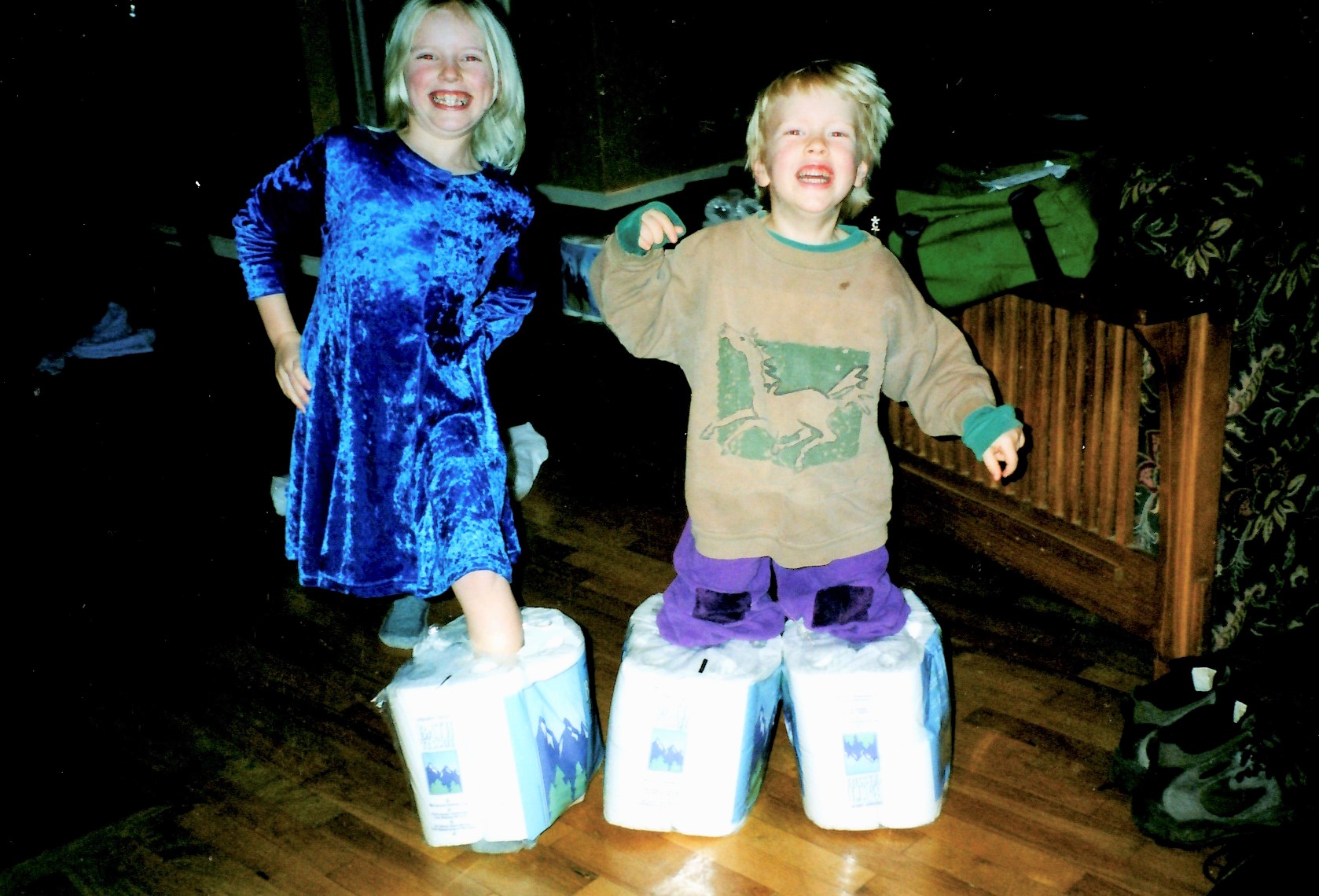
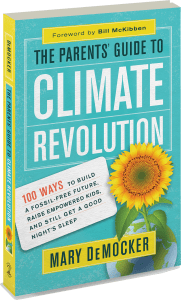
0 Comments